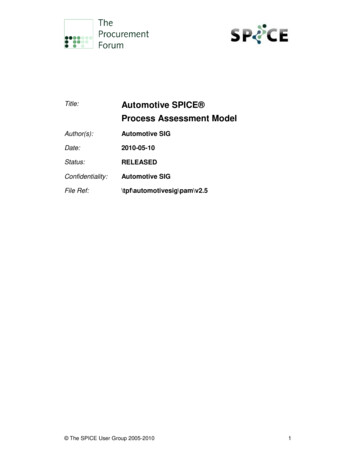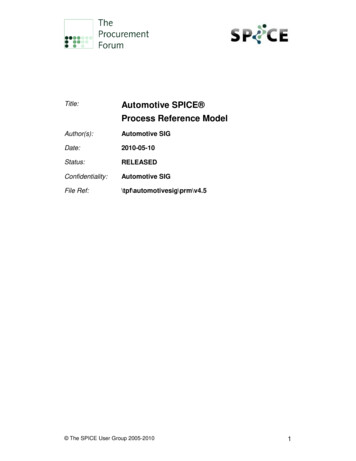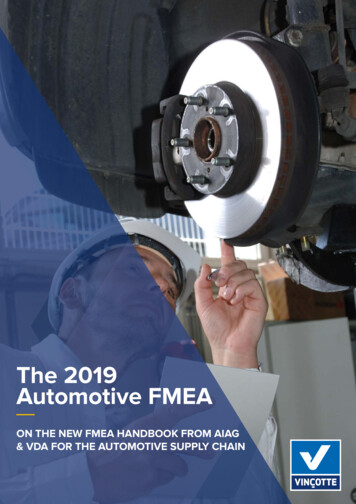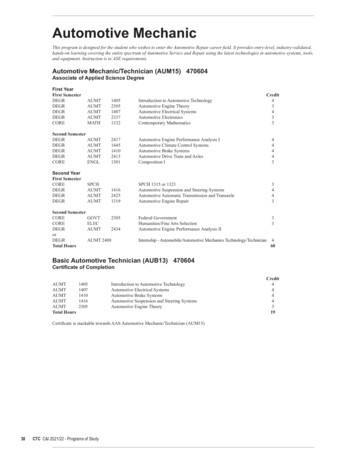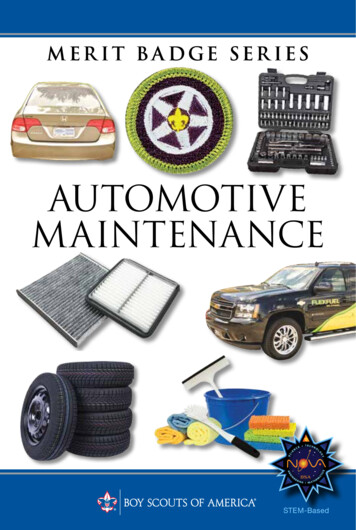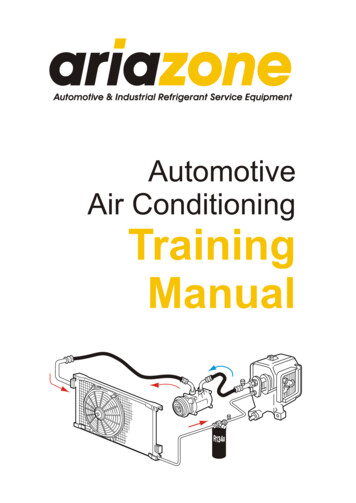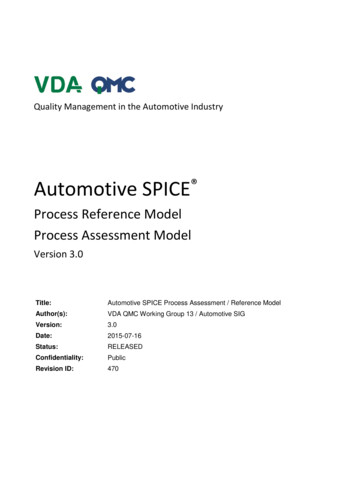
Transcription
Quality Management in the Automotive IndustryAutomotive SPICE Process Reference ModelProcess Assessment ModelVersion 3.0Title:Automotive SPICE Process Assessment / Reference ModelAuthor(s):VDA QMC Working Group 13 / Automotive entiality:PublicRevision ID:470
Copyright NoticeThis document is a revision of the Automotive SPICE process assessment model 2.5 and theprocess reference model 4.5, which has been developed under the Automotive SPICE initiative byconsensus of the car manufacturers within the Automotive Special Interest Group (SIG), a jointspecial interest group of Automotive OEM, the Procurement Forum and the SPICE User Group.It has been revised by the Working Group 13 of the Quality Management Center (QMC) in theGerman Association of the Automotive Industry with the representation of members of theAutomotive Special Interest Group, and with the agreement of the SPICE User Group. Thisagreement is based on a validation of the Automotive SPICE 3.0 version regarding any ISO copyrightinfringement and the statements given from VDA QMC to the SPICE User Group regarding thecurrent and future development of Automotive SPICE.This document reproduces relevant material from: ISO/IEC 33020:2015Information technology -- Process assessment -- Process measurement framework forassessment of process capabilityISO/IEC 33020:2015 provides the following copyright release statement:‘Users of this International Standard may reproduce subclauses 5.2, 5.3, 5.4 and 5.6 as part of anyprocess assessment model or maturity model so that it can be used for its intended purpose.’ ISO/IEC 15504-5:2006Information Technology – Process assessment – Part 5: An exemplar Process AssessmentModelISO/IEC 15504-5:2006 provides the following copyright release statement:‘Users of this part of ISO/IEC 15504 may freely reproduce the detailed descriptions contained in theexemplar assessment model as part of any tool or other material to support the performance ofprocess assessments, so that it can be used for its intended purpose.’Relevant material from one of the mentioned standards is incorporated under the copyright releasenotice.AcknowledgementThe VDA, the VDA QMC and the Working Group 13 explicitly acknowledge the high quality workcarried out by the members of the Automotive Special Interest Group. We would like to thank allinvolved people, who have contributed to the development and publication of Automotive SPICE . VDA Quality Management Center2
Derivative WorksYou may not alter, transform, or build upon this work without the prior consent of both the SPICEUser Group and the VDA Quality Management Center. Such consent may be given provided ISOcopyright is not infringed.The detailed descriptions contained in this document may be incorporated as part of any tool or othermaterial to support the performance of process assessments, so that this process assessment modelcan be used for its intended purpose, provided that any such material is not offered for sale.All distribution of derivative works shall be made at no cost to the recipient.DistributionThe Automotive SPICE process assessment model may only be obtained by download from thewww.automotivespice.com web site.It is not permitted for the recipient to further distribute the document.Change RequestsAny problems or change requests should be reported through the defined mechanism at thewww.automotivespice.com web site.TrademarkAutomotive SPICE is a registered trademark of the Verband der Automobilindustrie e.V. (VDA)For further information about Automotive SPICE visit www.automotivespice.com. VDA Quality Management Center3
Document HistoryVersionDateByNotes2.02005-05-04AutoSIG / SUGDRAFT RELEASE, pending final editorial review2.12005-06-24AutoSIG / SUGEditorial review comments implementedUpdated to reflect changes in FDIS 15504-52.22005-08-21AutoSIG / SUGFinal checks implemented: FORMAL RELEASE2.32007-05-05AutoSIG / SUGRevision following CCB: FORMAL RELEASE2.42008-08-01AutoSIG / SUGRevision following CCB: FORMAL RELEASE2.52010-05-10AutoSIG / SUGRevision following CCB: FORMAL RELEASE3.02010-07-16VDA QMC WG13Changes: See release notesRelease NotesVersion 3.0 of the process assessment model incorporates the following major changes:Chapter 1Editorial adaption to ISO/IEC 330xx series, Notes regarding combined PRM/PAM inthis documentChapter 2Adaption to ISO/IEC 330xx seriesChapter 3Text optimized for better understanding and adapted to ISO/IEC 330xx series.Chapter 4Renaming ENG to SYS/SWE, Structure of old ENG Processes changed, Rework ofAS 4.5 process reference model and AS 2.5 process performance indicatorsfocusing on a set of highly significant processes assessed within the automotiveindustry (HIS Scope).Chapter 5Adaption based on AS 2.5 to the measurement framework of ISO/IEC 33020Annex AConformity statement adapted to ISO/IEC 33004Annex BModifications on work product characteristics according to the changes in chapter 4.Annex CUpdate to recent standards. Introduction of specific terms used in AS 3.0Annex DAdded the major concepts used for AS 3.0, incorporated Annex E of AS 2.5Annex EUpdated references to other standards VDA Quality Management Center4
Table of contentsCopyright Notice . 2Acknowledgement. 2Derivative Works . 3Distribution . 3Change Requests . 3Trademark . 3Document History . 4Release Notes . 4Table of contents . 5List of Figures . 7List of Tables . 71. Introduction . 81.1.Scope . 81.2.Terminology. 91.3.Abbreviations . 92. Statement of compliance. 103. Process capability determination. 113.1.Process reference model . 123.1.1.Primary Life Cycle Processes Category . 133.1.2.Supporting Life Cycle Processes Category . 143.1.3.Organizational Life Cycle Processes Category . 143.2.Measurement framework . 153.2.1.Process capability levels and process attributes . 153.2.2.Process Attribute Rating . 163.2.3.Process capability level model . 203.3.Process assessment model . 213.3.1.Process Performance Indicators . 213.3.2.Process Capability Indicators . 223.3.3.Understanding the Level of Abstraction of a PAM . 224. Process reference model and performance indicators (Level 1) . 244.1.Acquisition Process Group (ACQ) . 254.1.1.ACQ.3 Contract Agreement . 254.1.2.ACQ.4 Supplier Monitoring . 264.1.3.ACQ.11 Technical Requirements . 274.1.4.ACQ.12 Legal and Administrative Requirements . 294.1.5.ACQ.13 Project Requirements . 304.1.6.ACQ.14 Request for Proposals . 324.1.7.ACQ.15 Supplier Qualification . 344.2.Supply Process Group (SPL) . 354.2.1.SPL.1 Supplier Tendering . 354.2.2.SPL.2 Product Release. 364.3.System Engineering Process Group (SYS). 384.3.1.SYS.1 Requirements Elicitation . 384.3.2.SYS.2 System Requirements Analysis. 394.3.3.SYS.3 System Architectural Design . 41 VDA Quality Management Center5
4.3.4.SYS.4 System Integration and Integration Test. 434.3.5.SYS.5 System Qualification Test . 454.4.Software Engineering Process Group (SWE) . 474.4.1.SWE.1 Software Requirements Analysis . 474.4.2.SWE.2 Software Architectural Design . 494.4.3.SWE.3 Software Detailed Design and Unit Construction . 504.4.4.SWE.4 Software Unit Verification . 524.4.5.SWE.5 Software Integration and Integration Test . 544.4.6.SWE.6 Software Qualification Test . 564.5.Supporting Process Group (SUP) . 584.5.1.SUP.1 Quality Assurance. 584.5.2.SUP.2 Verification . 594.5.3.SUP.4 Joint Review . 604.5.4.SUP.7 Documentation . 624.5.5.SUP.8 Configuration Management. 634.5.6.SUP.9 Problem Resolution Management . 654.5.7.SUP.10 Change Request Management . 674.6.Management Process Group (MAN) . 694.6.1.MAN.3 Project Management . 694.6.2.MAN.5 Risk Management . 714.6.3.MAN.6 Measurement . 724.7.Process Improvement Process Group (PIM) . 744.7.1.PIM.3 Process Improvement . 744.8.Reuse Process Group (REU). 764.8.1.REU.2 Reuse Program Management . 765. Process capability levels and process attributes . 785.1.Process capability Level 0: Incomplete process . 785.2.Process capability Level 1: Performed process . 785.2.1.PA 1.1 Process performance process attribute . 785.3.Process capability Level 2: Managed process . 785.3.1.PA 2.1 Performance management process attribute . 795.3.2.PA 2.2 Work product management process attribute . 815.4.Process capability Level 3: Established process . 825.4.1.PA 3.1 Process definition process attribute . 825.4.2.PA 3.2 Process deployment attribute . 845.5.Process capability Level 4: Predictable process . 865.5.1.PA 4.1 Quantitative analysis process attribute . 865.5.2.PA 4.2 Quantitative control process attribute . 875.6.Process capability Level 5: Innovating process . 885.6.1.PA 5.1 Process innovation attribute . 895.6.2.PA 5.2 Process optimization attribute . 90Annex AConformity of the process assessment and reference model . 92A.1Introduction. 92A.2Conformance to the requirements for process reference models . 92A.3Conformance to the requirements for process assessment models . 92Annex BWork product characteristics . 95Annex CTerminology . 123 VDA Quality Management Center6
Annex DD.1D.2D.3D.4D.5D.6D.7Annex EKey Concepts . 126The "Plug-in" Concept . 126The Tip of the "V" . 127Terms "Element", "Component", "Unit", and "Item" . 127Traceability and Consistency . 128"Agree" and "Summarize and Communicate" . 129"Evaluate", "Verification Criteria" and "Ensuring compliance" . 129The Relation Between "Strategy" and "Plan" . 130Reference Standards . 132List of FiguresFigure 1 — Process assessment model relationship . 11Figure 2 — Automotive SPICE process reference model - Overview . 12Figure 3 — Relationship between assessment indicators and process capability. 22Figure 4 — Possible levels of abstraction for the term "process" . 23Figure 5 — Performing a process assessment for determining process capability . 23Figure D.1 — The "Plug-in"-Concept. 126Figure D.2 — The tip of the "V" . 127Figure D.3 — Element, Component, Unit, and Item . 127Figure D.4 — Bidirectional Traceability and Consistency . 128Figure D.5 — Agree, summarize and communicate . 129Figure D.6 — Evaluation, verification criteria and compliance . 130Figure D.7— Strategy and plan . 131List of TablesTable 1 — Abbreviation List . 9Table 2 — Primary Life Cycle Processes – ACQ process group . 13Table 3 — Primary Life Cycle Processes – SPL process group . 13Table 4 — Primary Life Cycle Processes – SYS process group . 13Table 5 — Primary Life Cycle Processes – SWE process group . 14Table 6 — Supporting Life Cycle Processes - SUP process group . 14Table 7 — Organizational Life Cycle Processes - MAN process group . 14Table 8 — Organizational Life Cycle Processes - PIM process group . 15Table 9 — Organizational Life Cycle Processes - REU process group. 15Table 10 — Process Capability Levels according to ISO/IEC 33020 . 16Table 11 — Process Attributes according to ISO/IEC 33020 . 16Table 12 — Rating scale according to ISO/IEC 33020 . 17Table 13 — Rating scale percentage values according to ISO/IEC 33020 . 17Table 14 — Refinement of rating scale according to ISO/IEC 33020 . 17Table 15 — Refined rating scale percentage values according to ISO/IEC 33020 . 18Table 16 — Process capability level model according to ISO/IEC 33020 . 20Table C.1 — Terminology . 123Table E.1 — Reference standards . 132 VDA Quality Management Center7
1. Introduction1.1.ScopeProcess assessment is a disciplined evaluation of an organizational unit’s processes against aprocess assessment model.The Automotive SPICE process assessment model (PAM) is intended for use when performingconformant assessments of the process capability on the development of embedded automotivesystems. It was developed in accordance with the requirements of ISO/IEC 33004.Automotive SPICE has its own process reference model (PRM), which was developed based on theAutomotive SPICE process reference model 4.5. It was further developed and tailored consideringthe specific needs of the automotive industry. If processes beyond the scope of Automotive SPICEare needed, appropriate processes from other process reference models such as ISO/IEC 12207 orISO/IEC 15288 may be added based on the business needs of the organization.The PRM is incorporated in this document and is used in conjunction with the Automotive SPICEprocess assessment model when performing an assessment.This Automotive SPICE process assessment model contains a set of indicators to be consideredwhen interpreting the intent of the Automotive SPICE process reference model. These indicatorsmay also be used when implementing a process improvement program subsequent to anassessment. VDA Quality Management Center8
1.2.TerminologyAutomotive SPICE follows the following precedence for use of terminology:a) ISO/IEC 33001 for assessment related terminologyb) ISO/IEC/IEEE 24765 and ISO/IEC/IEEE 29119 terminology (as contained in Annex C)c) Terms introduced by Automotive SPICE (as contained in Annex SPICESUGUSBWPWPCAutomotive SPICEBase PracticeController Area NetworkComputer-Aided Software Engineering,Change Control BoardCall For ProposalsCentral Processing UnitElectronic Control UnitElectrically Erasable Programmable Read-Only MemoryGeneric PracticeGeneric ResourceHersteller Initiative Software www.automotive-his.deInternational Electrotechnical CommissionInstitute of Electrical and Electronics EngineersInput / OutputInternational Organization for StandardizationInvitation To TenderLocal Interconnect NetworkMotor Industry Software Reliability AssociationMedia Oriented Systems TransportProcess AttributeProcess Assessment ModelProcess Reference ModelPulse Width ModulationRandom Access MemoryRead Only MemorySoftware Process Improvement and Capability dEterminationSpice User GroupUniversal Serial BusWork ProductWork Product CharacteristicTable 1 — Abbreviation List VDA Quality Management Center9
2. Statement of complianceThe Automotive SPICE process assessment model and process reference model is conformant withthe ISO/IEC 33004, and can be used as the basis for conducting an assessment of processcapability.ISO/IEC 33020 is used as an ISO/IEC 33003 compliant Measurement Framework.A statement of compliance of the process assessment model and process reference model with therequirements of ISO/IEC 33004 is provided in Annex A. VDA Quality Management Center10
3. Process capability determinationThe concept of process capability determination by using a process assessment model is based ona two-dimensional framework. The first dimension is provided by processes defined in a processreference model (process dimension). The second dimension consists of capability levels that arefurther subdivided into process attributes (capability dimension). The process attributes provide themeasurable characteristics of process capability.The process assessment model selects processes from a process reference model and supplementswith indicators. These indicators support the collection of objective evidence which enable anassessor to assign ratings for processes according to the capability dimension.The relationship is shown in Figure 1:Measurement framework(ISO/IEC 33020) Capability levelsProcess attributesRating Scale Rating method Aggregation method Process capability level modelProcess assessment model(Automotive SPICE) Process capability indicatorsProcess performance indicatorsProcess1Process2Process3Process4 .Process reference model(Automotive SPICE) Domian and scopesProcess purposesProcess outcomesFigure 1 — Process assessment model relationship VDA Quality Management Center11
3.1.Process reference modelProcesses are grouped by process category and at a second level into process groups according tothe type of activity they address.There are 3 process categories: Primary Life Cycle Processes, Organizational Life Cycle Processesand Supporting Life Cycle Processes.Each process is described in terms of a purpose statement. The purpose statement contains theunique functional objectives of the process when performed in a particular environment. For eachpurpose statement a list of specific outcomes is associated, as a list of expected positive results ofthe process performance.For the process dimension, the Automotive SPICE process reference model provides the set ofprocesses shown in Figure 2.Acquisition ProcessGroup (ACQ)System Engineering Process Group (SYS)ACQ.3Contract AgreementManagement ProcessGroup (MAN)SYS.1MAN.3Requirements ElicitationProject ManagementSYS.2ACQ.4SYS.5System RequirementsAnalysisSupplier MonitoringSYS.3ACQ.11System ArchitecturalDesignTechnical RequirementsMAN.5System Qualification TestRisk ManagementSYS.4MAN.6System Integration andIntegration TestMeasurementACQ.12Legal and AdministrativeRequirementsSoftware Engineering Process Group (SWE)SWE.1ACQ.13Software Qualification TestSWE.2ACQ.14Software ArchitecturalDesignRequest for ProposalsSWE.3ACQ.15Software Detailed Designand Unit ConstructionSupplier QualificationSupply Process Group(SPL)SWE.5Software Integration andIntegration TestReuse Process Group(REU)SWE.4Software Unit VerificationREU.2Reuse ProgramManagementSupporting Process Group (SUP)SPL.1Supplier TenderingSWE.6Software RequirementsAnalysisProject RequirementsSUP.1Quality AssuranceSPL.2Product ReleaseSUP.2VerificationSUP.4Joint em ResolutionManagementChange RequestManagementPrimary Life Cycle ProcessesOrganizational Life Cycle ProcessesSUP.7DocumentationProcess ImprovementProcess Group (PIM)PIM.3Process ImprovementSupporting Life Cycle ProcessesFigure 2 — Automotive SPICE process reference model - Overview VDA Quality Management Center12
3.1.1. Primary Life Cycle Processes CategoryThe primary life cycle processes category consists of processes that may be used by the customerwhen acquiring products from a supplier, and by the supplier when responding and deliveringproducts to the customer including the engineering processes needed for specification, design,development, integration and testing.The primary life cycle processes category consists of the following groups: the Acquisition process group;the Supply process group;the System Engineering process group;the Software Engineering process group.The Acquisition process group (ACQ) consists of processes that are performed by the customer, orby the supplier when acting as a customer for its own suppliers, in order to acquire a product and/orservice.ACQ.3Contract AgreementACQ.4Supplier MonitoringACQ.11Technical RequirementsACQ.12Legal and Administrative RequirementsACQ.13Project RequirementsACQ.14Request for ProposalsACQ.15Supplier QualificationTable 2 — Primary Life Cycle Processes – ACQ process groupThe Supply process group (SPL) consists of processes performed by the supplier in order to supplya product and/or a service.SPL.1Supplier TenderingSPL.2Product ReleaseTable 3 — Primary Life Cycle Processes – SPL process groupThe System Engineering process group (SYS) consists of processes addressing the elicitation andmanagement of customer and internal requirements, the definition of the system architecture andthe integration and testing on the system level.SYS.1Requirements ElicitationSYS.2System Requirements AnalysisSYS.3System Architectural DesignSYS.4System Integration and Integration TestSYS.5System Qualification TestTable 4 — Primary Life Cycle Processes – SYS process groupThe Software Engineering process group (SWE) consists of processes addressing the managementof software requirements derived from the system requirements, the development of the VDA Quality Management Center13
corresponding software architecture and design as well as the implementation, integration andtesting of the software.SWE.1Software Requirements AnalysisSWE.2Software Architectural DesignSWE.3Software Detailed Design and Unit ConstructionSWE.4Software Unit VerificationSWE.5Software Integration and Integration TestSWE.6Software Qualification TestTable 5 — Primary Life Cycle Processes – SWE process group3.1.2. Supporting Life Cycle Processes CategoryThe supporting life cycle processes category consists of processes that may be employed by any ofthe other processes at various points in the life cycle.SUP.1Quality AssuranceSUP.2V
Quality Management in the Automotive Industry Automotive SPICE Process Reference Model Process Assessment Model Version 3.0 Title: Automotive SPICE Process Assessment / Reference Model Author(s): VDA QMC Working Group 13 / Automotive SIG Version: 3.0 Date: 2015-07-16 Status: RELEASED Confidentiality: Public Revision ID: 470
